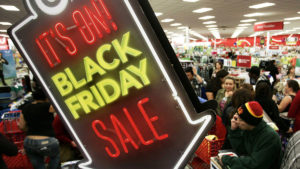 MarkMonitor, the global leader in enterprise brand protection is advising online shoppers to be more vigilant leading up to Black Friday. In the annual search for bargains and discounted goods, consumers are more at risk when it comes to unintentionally buying counterfeit goods.
MarkMonitor, the global leader in enterprise brand protection is advising online shoppers to be more vigilant leading up to Black Friday. In the annual search for bargains and discounted goods, consumers are more at risk when it comes to unintentionally buying counterfeit goods.
The last weekend in November is designated ‘Cyber Weekend’ and stretches from Black Friday, through to Cyber Monday. In 2016, according to IMRG, UK shoppers spent £1.23 billion online, on Friday alone. The four-day weekend saw shoppers spending £5.8 billion, 15% more than they did in 2015.
It is expected that the trend will continue this year. But as the Internet and mobile become even more popular places to shop and retailers are benefiting from a global marketplace, there are also many risks associated with shopping online. With more good deals to be had, how can bargain hunters scouring the Internet ensure they are getting the real deal and are not being caught out by fake goods? Fraudsters target peak shopping periods and counterfeit goods are harder to spot because they are often priced at similar levels as the genuine article.
Charlie Abrahams, senior vice president from online brand protection specialist MarkMonitor, says: “There used to be a belief that people were deliberately buying fakes as they are cheaper but last year we found that 23% of bargain-hunters had been duped by counterfeiters. This showed a majority of these consumers were buying them by mistake. They are searching for bargains and in turn are buying counterfeit goods without knowing it.”
No matter how Internet or business savvy you are, there five key aspects to consider when buying online:
Price: Counterfeiters are wising up and realising that sometimes it can be more convincing the less the item is reduced. Search around for the recommended retail price (RRP) and even if the item only has a small discount, such as 20%, it is worth checking other elements of the website to see if they stack up.
The site itself: Although some websites look professional at first glance, counterfeiters aren’t always so careful about the ‘About’ or ‘FAQ’ page. Check these sections and make sure you look at the delivery details and note where the company is based, does it match up with the company’s details? Also, look at the delivery options – less reputable sites won’t bother with this.
Return and Privacy Policies: These should be clear if it’s a reputable site. A bona fide seller should provide an option of how to cancel orders and where to return goods. Counterfeiters won’t usually invest the time to craft a clear, strong privacy policy, so if there isn’t one on the website, be warned.
Check the web address: Impersonation of a brand’s website and what is referred to as ‘cybersquatting’ are on the rise. When doing an initial search for the brand name, check the link and look out for spelling mistakes on both the website and the URL address. If the address begins with https://, the ‘s’ tells you it’s a secure site. Some of the big brands have dedicated pages on their websites so consumers can check whether a seller is authorised.
Online marketplaces: Even if the marketplace itself is a brand you know, check reviews of the seller or try find any forum chats and speak to other retailers before placing that order.
As the ramp up to the festive season continues, consumers need to be vigilant when shopping online and ensure they follow a few fundamentals to keep clear of falling prey to counterfeiters. In turn, brands need to do all they can to protect their customers during this busy, high-risk time.
Source: MarkMonitor

You must be logged in to post a comment Login